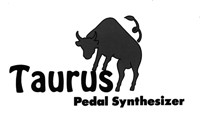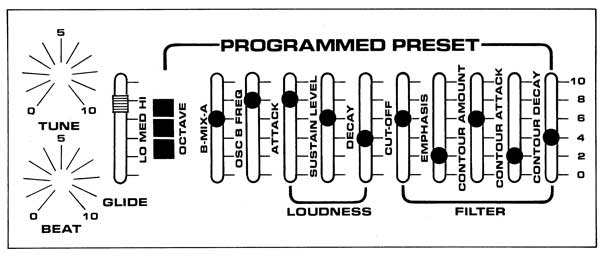
Information from
Moog Literature

Information from
Moog Literature
Introduction
THE MOOG TAURUS IS A FOOT-CONTROLLED PEDAL SYNTHESIZER COMBINING THE FEATURES OF A SYNTHESIZER—GOOD SOUND AND VERSATILITY—WITH FOOT CONTROLLED SOUND MODIFIERS AND PRESETS.
THIS VERSATILE MUSICAL INSTRUMENT OFFERS THE CAPABILITY OF PRODUCING TRADITIONAL OR NEW SOUNDS, INSTANTLY SELECTABLE FROM THE FOOT-CONTROLLED PRESETS. ONE OF THESE PRESETS IS FULLY PROGRAMMABLE SO THAT THE PLAYER MAY SET UP A "SOUND" AND GET TO IT INSTANTLY.
TO PROVIDE MAXIMUM PROTECTION, THE UNIT IS ASSEMBLED IN A RUGGED WOOD AND METAL HOUSING.
Description
The basic functions of the Taurus Synthesizer (see accompanying block diagram) are programmable. That is, values of the various parametersthat are used to control the details of a sound are determined either by the internally fixed values (for the three fixed presets) or set by the player accessible controls (for the VARI ABLE preset). In normal usage, the VARIABLE preset is set up prior to performance using the VARIABLES controls in the control box. During actual performance, the player selects one of the four presets instantly by depressing one of the four PRESETS foot-buttons. These four PRESETS are mutually exclusive, that is, only one preset may be ON at any one time.

The basic tone sources are two voltage controlled oscillators (A and B). Two basic pitch controls are used for fine tuning the instrument. First, the TUNE control is used to set the pitch of both oscillators to the desired reference, such as another instrument being used simul taneously. The BEAT control is used to make fine adjustments in the relative pitch of the two tone oscillators (by modifying the "B" tone source pitch). In addition to these basic tuning controls, the "B" tone osciliator pitch in the VARIABLE preset mode may be varied over a greater than one octave range by adjust ing the OSC B FREQ control. The relative pitches of the two tone sources are internally set for the three fixed presets.
The entire instrument may be shifted either up or down one octave by use of the OCTAVE foot-button. As the OCTAVE foot-button is successively depressed, the instrument tuning changes by one octave; an indicator light shows that the instrument tuning is in high range. For the three fixed presets, the OCTAVE button switches the instrument between the 16' and 8' ranges. When the instrument is in the VARIABLE mode, a manual OCTAVE slide switch in the VARIABLES control box may be used to select three pitch range positions (LO-MED-HI). These three positions correspond to a 16' or 8' range for the LO position, an 8' or 4' range for the MED position, and a 4' or 2' range for the Hl position. The "B" oscillator range extends to 1' with the OSC B FREQ control positioned all the way up.
The instantaneous pitch of the instrument is controlled not onty by the OCTAVE and fine tuning controls, but also by a GLIDE control and GLIDE foot-button. The glide effect is a smooth transition in pitch between successive notes. The GLIDE foot-button operates in a manner similar to the OCTAVE foot-button in that the glide effect can be alternately turned ON and OFF, the ON state indicated by the GLIDE light being ON. The amount of glide effect is determined by the GLIDE slider in the VARIABLES control box. The player may thus set up the amount of desired glide effect using the GLIDE slider and then use the GLIDE foot-button to switch the effect in or out.
The two tone sources are combined in different amounts in the mixer. In the three fixed presets the amounts are internally set, while in the VARIAB LE MODE the relative amounts of the "A" and "B" tone sources appearing in the final output are determined by the B-MIX-A control in the VARIABLES control box.
The output of the mixer is applied to the voltage controlled filter which may be used to provide either dynamic or fixed timbre modification. Whenever a note is depressed, a filter contour signal is generated, successively opening and closing the filter. The amount of opening and closing the filter is determined by the CONTOUR AMOUNT slider. The rate at which the filter is opened is determined by the CONTOUR ATTACK control slider while the rate at which the filter is closed is determined by the CONTOUR DECAY slider. These contour controls determine the characteristics of the dynamic aspect of the filter function.

The effect of the filter is determined by the settings of the contour controls and by two other controls (CUT-OFF and EMPHASIS). The cutoff frequency is the filter characteristic which is "moved" by the contour signal. The initial cutoff frequency is determined by the FILTER foot-slider and by internally preset values for the three fixed presets. For the VARIABLE preset, this initial filter cutoff frequency is determined by the FILTER foot-slider and by the CUT-OFF control in the VARIABLES control box. For example, using the VARIABLE preset with the CONTOUR AMOUNT control set all the way down, the tone color may be changed but not dynamically, by either the FILTER foot-slider or the CUT-OFF slider.
The EMPHASIS control varies the amount of peaking of the filter. That is, the intensity of the frequency components of the tone generators which lay near the filter cutoff frequency is emphasized to a degree determined by the EMPHASIS control.
The output signal from the voltage controlled filter is applied to the voltage controlled amplifier (VCA). The VCA serves the function of "turning on and turning off" the sound. This articulation of the signal is caused by the VCA contour generator. The rate at which the sound is "turned on" is called the attack time. This attack time is internally set for the three fixed presets and is set by the ATTACK control in the VARIABLES control box for the VARIABLE preset. The sustained loudness of a preset is called the SUSTAIN LEVEL. The SUSTAIN LEVEL is determined by an internally preset value for the three fixed presets, and by the SUSTAIN LEVEL control for the VARIABLE preset. In addition, the overall loudness is determined by the LOUDNESS foot-slider. The manner in which the sound dies out or decays is determined by two functions. If the DECAY light is ON, the sound dies out at a rate determined by the DECAY control in the VARIABLES control box for the VARIABLE preset. If the DECAY light is OFF, the sound dies out immediately when the note is released (no decay).
The output of the VCA is applied to the OUTPUT LEVEL rotary control on the inset rear panel. The OUTPUT LEVEL control is used to match the signal level of the Taurus to the amplifier. GeneralIy, the OUTPUT LEVEL control will be set so that the maximum desired loudness for any preset is achieved when both the LOUDNESS and the FILTER foot-sliders are in their uppermost positions. When using the TAURUS with a bass amplifier or similar musical instrument amplifier, plug the TAURUS into a high level amplifier input, and set the amplifier volume control one-third to one-half of the way up. Then set the OUTPUT LEVEL control on the Taurus rear panel for the desired volume range.
The Taurus may be operated using either a 115 or 230 volt line voltage.
(From 1978 Norlin Music Taurus Pedal Synthesizer Owners and Service Manual)
Moog Taurus Moog Taurus Flyer
Moog Taurus Owner's Manual Description, Block Diagram & Programmed Preset Diagram
Moog Music Custom Engineering Big Briar, Inc.(Bob Moog today)
(From The Terrey Collection of Literature)
Old Tech Home Old Tech Synth Site Home
Old Tech - Books & Things, P.O. Box 803, Carlisle, MA 01741
Tel: (978) 371-2231; Fax: (978) 371-7129; Email: jvt@oldtech.com
John V. Terrey, Proprietor
The information on this site is believed to be correct, however, use at your own risk.
Copyright 1999 John V. Terrey. Unauthorized use of any of the contents is in violation of copyright law.
Site designed on Macintosh computer using GoLive, ImageReady, Filemaker, Photoshop.
Scanner: Agfa T-1200. Camera: Agfa CL50.